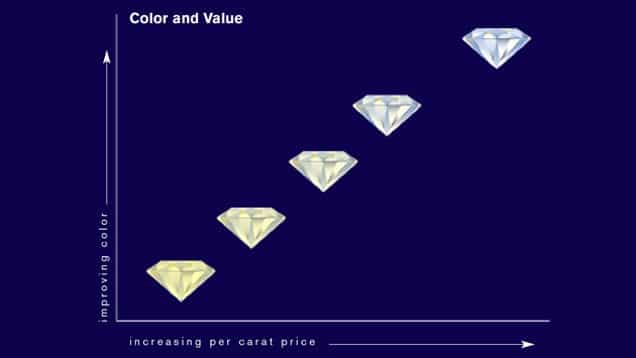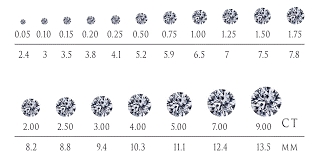You’re at the jewelry store, trying to find the perfect ring for your perfect someone. You’ve prepared yourself for how much it will cost, but when it comes down to actually paying, all you can think of is, “How the heck do they even come up with these prices? How do they know if a diamond is “good” or not?”
Diamonds are rated based on a system created by the Gemologists Institute of America (GIA), that rates a diamond’s quality based on the qualities of cut, carat weight, clarity, and color. Each of these qualities has its own scale, which comes together to determine a diamond’s final rating.
Quite a few things are included in grading diamonds for quality. Gemologists will grade a diamond, looking at every aspect: the angles, edges, the shape, and even the light it reflects. This article will explain the process that a diamond goes through in order to be graded for its quality.
Keep reading to learn how the color, clarity, cut, and carat weight are all measured in order to give the diamond its final grade.
How is a Diamond’s Cut Rated?
The cut of a diamond is the most important factor in grading its quality. How a diamond is cut obviously dictates the size and shape, but it also determines other factors like the reflection of light in the stone, which is key to diamond quality. This means that when a diamond is being graded, the skill of the cutter is also being graded.
To grade the quality of the diamond’s cut, graders will look at the proportions of the diamond’s edges and angles, how symmetrical the diamond is, and the final polish. They also measure the light that reflects within the diamond. The cut is so crucial because the proportions of a diamond dictate how much light reflects in the diamond and where it reflects from.

A grader will use a special light is used to determine the brilliance, fire, and scintillation of a diamond. Brilliance is the light reflected from the diamond, fire is the light when it’s transformed into the colors of the rainbow, and scintillation is how much a diamond sparkles from the light it’s reflecting.
The GIA’s Diamond Cut scale goes from Excellent to Poor. Let’s take a closer look.
- Excellent-grade diamonds have a steady pattern of both light and dark spots. The light enters and reflects exactly the way it’s supposed to, without any escape through the bottom or sides. Only 3% of all diamonds have this cut grade.
- Very Good graded diamonds are cut almost perfectly. Almost all of the light is captured and there’s minimal escaped light. This cut can enhance color, clarity, and carat quality.
- Good Diamonds only a small amount of light escapes from the sides or bottom of the diamond, most of it comes from the top. Most diamonds are specifically cut to reach this grade, combining size and value.
- Poorly cut diamonds let out a lot of light from the bottom and sides because they are cut too shallow or too deep for the light to properly reflect out the top. These diamonds don’t usually make the cut and are avoided by retailers because there’s really no aesthetic appeal.
More about the Cut Rating:
- What Is The Cheapest Diamond Cut?
- What Diamond Cut Looks the Biggest?
- Diamond Shape vs Diamond Cut: What’ the Difference?
How is a Diamond’s Color Rated?
The color in a diamond can range from colorless, which is extremely rare, to yellow. Though subtle, the color tone of a diamond can drastically affect its value. When a diamond grader evaluates the color of a diamond, they will look for any yellow tones present in the stone.

A diamond gets its color grade by being put under special lighting and compared to master stones, also known as benchmarks, that are on ideal places on the color scale. The color scale is from D-Z, with D being the highest grade, and Z being the lowest grade. Here’s how the color scale goes:
- D-F rated diamonds are rated colorless. These stones are extremely rare and more valuable than any other color grade.
- G-J rated diamonds are nearly colorless, with very faint tones of yellow that are nearly invisible.
- K rated means that the diamond has a faint color that is also almost impossible to see without special lighting.
- L-Z rated diamonds are stones that have visible color tones. Higher-end retailers usually won’t sell a diamond with a grade Lower than M.
Colored diamonds, also known as Fancy diamonds, are graded on a completely different scale that focuses on the vibrancy of the color. It ranges from faint color to fancy vivid, which is the highest grade for colored diamonds.
More about the Color Rating:
How is a Diamond’s Clarity Rated?
The clarity of a diamond is how many marks or flaws it has, both inside and outside. These flaws are called inclusions and blemishes. Inclusions are flaws that happen on the inside of a diamond, while blemishes are on the outside.
These flaws happen during the process that the diamond is created and during the cutting process. However, the goal of a diamond cutter is to cut the diamond as finely and carefully as possible, without any flaws on the top of the diamond.
The inclusions and blemishes on a diamond can obstruct light reflection and general brilliance of a diamond. This means that the more flaws a diamond has, the lower grade it will have, and the less valuable it will be.

The process of grading diamond clarity involves putting the stone under magnification and given a grade that works on an 11-point system.
- Flawless (FL) is the highest grade. These diamonds have no flaws, inside or out. They are super rare and cost quite a bit of money.
- Internally Flawless (IF) is a diamond that is flawless on the inside, however, there are external blemishes that can be seen under magnification.
- Very, Very Slightly Included (VVS1 & VVS2) diamonds have inclusions that are present on the inside, but very hard to see, even under magnifications.
- Very Slightly Included (VS1 & VS2) means that slight inclusions on the diamond are only noticeable under magnification. Usually only seen by skilled graders
- Slightly Included (SI1 & SI2) graded diamonds have mediocre flaws that may sometimes be visible to the naked eye.
- Included (I1, I2, I3) diamonds have inclusions and blemishes that are noticeable to the naked eye. These diamonds have so many flaws that higher-end retailers won’t even sell them. Because they are deemed less durable.
More about the Clarity Rating:
How is a Diamond’s Carat Weight Rated?
Carats are a unit of weight measurement used with diamonds. One carat is equal to 200 milligrams or 0.02 grams. Unlike color, cut, and clarity, there really isn’t a scale for grading carat quality. Instead, it’s more of a math problem.
The equations that the GIA uses goes like this: Carat Weight=Diameter x Diameter x Depth x 0.006. The diameters are measured by looking at the width of the top, as well as the center of the diamond, while the carats of a diamond are measured with extreme detail, splitting every carat into 100 points.
They are weighed using a carefully calibrated scale and then measured at 1000 carats for even more accuracy. Then, they are rounded to a hundredth. This is why they have two decimal points. Example: 0.025 carats is a low grade and 5.0 is a high grade.

The weight doesn’t always mean the same thing as size or even value. For example, a diamond with too deep of a pavilion has more bottom weight. This also means that the brilliance of the diamond won’t be optimal, making it less valuable. So, even though a diamond may be bigger, this doesn’t always mean that it’s going to be better, in regard to quality.
While there isn’t exactly a chart that goes with this grading system, here’s a scale that converts carats to millimeters, just to put it in perspective for you!
More about the Carat Weight Rating:
- Where Do The Prices For “Price Per Carat” Come From?
- How Are Diamond Costs Calculated?
- The Best Ways to Research Diamond Prices
Now you know how Diamonds are Rated!
As you can see, there’s a lot that goes into grading a diamond for quality. Diamond graders not only have an impeccable eye for detail, but they’re also specifically trained in the physics and physical attributes of a diamond.
Using the system created by the GIA, diamond graders look carefully at the color, cut, clarity, and carat weight. Each of these has a scale or system of grading, which all combine to determine a diamond’s value.
Remember, a bigger diamond isn’t always a better diamond. While rarity is also a factor, when it really comes down to a diamond’s quality and value, the brilliance and light reflection of a diamond are essential.
The next time you’re looking for a diamond ring, now you’ll know exactly what to look for!
